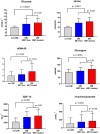Metformin treatment is associated with improved outcome in patients with diabetes and advanced heart failure (HFrEF)
- PMID: 35906276
- PMCID: PMC9338272
- DOI: 10.1038/s41598-022-17327-4
Metformin treatment is associated with improved outcome in patients with diabetes and advanced heart failure (HFrEF)
Abstract
The role of metformin (MET) in the treatment of patients with advanced HFrEF and type 2 diabetes mellitus (DM) is not firmly established. We studied the impact of MET on metabolic profile, quality of life (QoL) and survival in these patients. A total of 847 stable patients with advanced HFrEF (57.4 ± 11.3 years, 67.7% NYHA III/IV, LVEF 23.6 ± 5.8%) underwent clinical and laboratory evaluation and were prospectively followed for a median of 1126 (IQRs 410; 1781) days for occurrence of death, urgent heart transplantation or mechanical circulatory support implantation. A subgroup of 380 patients (44.9%) had DM, 87 of DM patients (22.9%) were treated with MET. Despite worse insulin sensitivity and more severe DM (higher BMI, HbA1c, worse insulin resistance), MET-treated patients exhibited more stable HF marked by lower BNP level (400 vs. 642 ng/l), better LV and RV function, lower mitral and tricuspid regurgitation severity, were using smaller doses of diuretics (all p < 0.05). Further, they had higher eGFR (69.23 vs. 63.34 ml/min/1.73 m2) and better QoL (MLHFQ: 36 vs. 48 points, p = 0.002). Compared to diabetics treated with other glucose-lowering agents, MET-treated patients had better event-free survival even after adjustment for BNP, BMI and eGFR (p = 0.035). Propensity score-matched analysis with 17 covariates yielded 81 pairs of patients and showed a significantly better survival for MET-treated subgroup (p = 0.01). MET treatment in patients with advanced HFrEF and DM is associated with improved outcome by mechanisms beyond the improvement of blood glucose control.
© 2022. The Author(s).
Conflict of interest statement
Josef Kautzner is a member of Advisory Boards for Bayer, Boehringer Ingelheim, Daiichi Sankyo, Biosense Webster, Medtronic and St Jude Medical (Abbott). He has received speaker honoraria from the above-mentioned companies and from Biotronik, Mylan, Pfizer and Pro Med. Petr Jarolim received research support from Abbott Laboratories, Amgen Inc., AstraZeneca LP, Beckman Coulter, Daiichi Sankyo, Inc., GlaxoSmithKline, Merck & Co., Inc., Roche Diagnostics Corporation, Takeda Global Research and Development Center and Waters Technologies Corporation and speaker honoraria from Roche Diagnostics Corporation. All other authors have no competing interest to declare.
Figures



Similar articles
-
Contemporary Treatment Patterns and Clinical Outcomes of Comorbid Diabetes Mellitus and HFrEF: The CHAMP-HF Registry.JACC Heart Fail. 2020 Jun;8(6):469-480. doi: 10.1016/j.jchf.2019.12.015. Epub 2020 May 6. JACC Heart Fail. 2020. PMID: 32387066
-
[Efficacy and safety of the use of metformin in patients with chronic heart failure and type 2 diabetes mellitus. results of the study "rational effective mulicomponent therapy in the battle against diabetes mellitus in patients with chronic heart failure"].Kardiologiia. 2008;48(3):58-68. Kardiologiia. 2008. PMID: 18429758 Clinical Trial. Russian.
-
Mealtime 50/50 basal + prandial insulin analogue mixture with a basal insulin analogue, both plus metformin, in the achievement of target HbA1c and pre- and postprandial blood glucose levels in patients with type 2 diabetes: a multinational, 24-week, randomized, open-label, parallel-group comparison.Clin Ther. 2007 Nov;29(11):2349-64. doi: 10.1016/j.clinthera.2007.11.016. Clin Ther. 2007. PMID: 18158076 Clinical Trial.
-
Quality of life in patients with heart failure and improved ejection fraction: one-year changes and prognosis.ESC Heart Fail. 2022 Dec;9(6):3804-3813. doi: 10.1002/ehf2.14098. Epub 2022 Aug 2. ESC Heart Fail. 2022. PMID: 35916351 Free PMC article. Review.
-
Use of Sodium-Glucose Cotransporter-2 Inhibitors in Clinical Practice for Heart Failure Prevention and Treatment: Beyond Type 2 Diabetes. A Narrative Review.Adv Ther. 2022 Feb;39(2):845-861. doi: 10.1007/s12325-021-01989-z. Epub 2021 Dec 9. Adv Ther. 2022. PMID: 34881413 Free PMC article. Review.
Cited by
-
Anti-Diabetic Therapy and Heart Failure: Recent Advances in Clinical Evidence and Molecular Mechanism.Life (Basel). 2023 Apr 16;13(4):1024. doi: 10.3390/life13041024. Life (Basel). 2023. PMID: 37109553 Free PMC article. Review.
-
A consensus statement from the Japan Diabetes Society (JDS): a proposed algorithm for pharmacotherapy in people with type 2 diabetes-2nd Edition (English version).Diabetol Int. 2024 Jul 11;15(3):327-345. doi: 10.1007/s13340-024-00723-8. eCollection 2024 Jul. Diabetol Int. 2024. PMID: 39101173 Free PMC article.
-
Ongoing and Future Clinical Trials of Pharmacotherapy for Heart Failure.Am J Cardiovasc Drugs. 2024 Jul;24(4):481-504. doi: 10.1007/s40256-024-00658-0. Epub 2024 Jun 22. Am J Cardiovasc Drugs. 2024. PMID: 38907865 Review.
-
Cardiometabolic Dysregulation and Heart Failure.Rev Cardiovasc Med. 2025 May 22;26(5):38504. doi: 10.31083/RCM38504. eCollection 2025 May. Rev Cardiovasc Med. 2025. PMID: 40475725 Free PMC article. Review.
-
A consensus statement from the Japan Diabetes Society: A proposed algorithm for pharmacotherapy in people with type 2 diabetes - 2nd edition (English version).J Diabetes Investig. 2024 Sep;15(9):1326-1342. doi: 10.1111/jdi.14202. Epub 2024 Jul 11. J Diabetes Investig. 2024. PMID: 38988282 Free PMC article.
References
Publication types
MeSH terms
Substances
LinkOut - more resources
Full Text Sources
Medical
Research Materials
Miscellaneous

